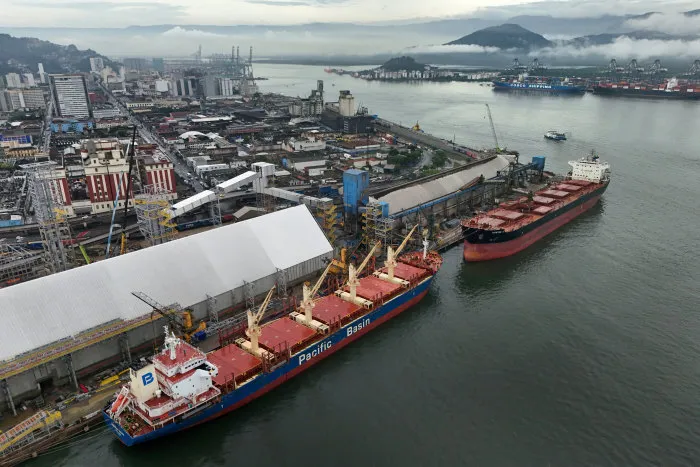China’s Ambitious Megaport Projects in South America: A Gateway for Agricultural Trade
In recent years, China has increasingly turned its eyes towards South America, a continent rich in natural resources and agricultural potential. Among the various initiatives undertaken by the Chinese government, the construction of megaports has emerged as a key focus, aiming to enhance food imports to satisfy China’s growing population. This article takes a closer look at China’s investments in South American ports, specifically discussing the developments in Brazil and the emerging railway connection between Brazil and Peru.
The Need for Agricultural Imports
China’s rise as an economic powerhouse has been accompanied by a dramatic increase in its demand for food commodities. The country’s agricultural output is often insufficient to meet the nutritional needs of its vast population, prompting the government to seek international sources for staple crops, including soybeans, corn, and meat. In this context, South America—currently one of the leading suppliers of agricultural products—has become an indispensable partner for China.
Chinese Investments in South American Ports
In an effort to secure stable supply routes for essential food imports, China has been investing heavily in the construction and modernization of megaports across South America. A prime example is the Port of Santos in Brazil. As the largest port in Latin America, it has been an attractive target for Chinese investment due to its strategic importance and capacity to handle large volumes of agricultural exports.
China has also eyed ports in Peru, specifically the Port of Callao, which plays a vital role in facilitating trade between the Pacific Rim and South America. Investments in these ports not only aim to enhance logistics but also to improve the efficiency and capacity of agricultural exports to China.
Bilateral Relations: China and Brazil
The partnership between China and Brazil has deepened significantly in recent years, as the two nations have engaged in various economic and diplomatic exchanges. In 2019, Brazil exported over $67 billion worth of goods to China, with soybeans being the crown jewel of their trading relationship. Recognizing the potential of Brazil as a key supplier of agricultural commodities, China is eager to continue expanding its footprint in the country.
Chinese investments in Brazilian infrastructure aim not only to bolster trade but also to foster stronger diplomatic ties. Historically, Brazil has maintained a complex relationship with China, balancing its own domestic agricultural industry requirements with the growing demand for exports.
The Brazil-Peru Biocean Rail: A Game Changer
One of the most significant developments in the region is the construction of the Brazil-Peru Biocean Rail, a broad-gauge railway designed to connect the Brazilian interior with the Peruvian port along the Pacific coast. Ideally located, this railroad will facilitate the transport of goods, particularly agricultural products, from Brazil to the rapidly growing markets in Asia, particularly China.
As of now, the project is approximately 39% complete, with works proceeding steadily despite the challenges posed by the rugged terrain and complex logistical requirements. The Biocean Rail is expected to improve trade efficiency significantly, reducing transit times and costs for Brazilian agricultural exports.
Implications for the Region
The development of megaports and transportation infrastructure in South America is not only limited to boosting trade with China. Such initiatives hold the potential to transform the region’s agricultural landscape. The improved logistics could lead to increased agricultural output, giving farmers better access to international markets.
However, with these developments also come challenges and concerns. Environmental implications, social impact on local communities, and potential disruptions to local economies must be addressed avidly. Sustainable development practices should be prioritized to ensure that South America’s rich agricultural ecosystems and local populations are not adversely affected.
Collaboration Opportunities
The economic interests of China are clear, but so too are the opportunities for South American countries to leverage these developments for their own benefit. Both Brazil and Peru stand to gain significantly if they position themselves strategically within this evolving trade network.
Collaboration among countries in the region can lead to shared infrastructure costs and promotional efforts aimed at attracting more international investment. By working in partnership, these nations can optimize the benefits of China’s investments while also safeguarding their own economic interests.
Future Prospects
As China continues to forge its presence on the South American continent, the long-term implications for bilateral trade relations and regional economics may be profound. With ongoing investments in infrastructure, logistics, and agriculture, the partnership could lead to a robust food supply chain that benefits both China and South American producers.
Looking ahead, as the Biocean Rail nears completion and the megaports in Brazil and Peru bolster their operations, the agricultural sector in South America may be on the brink of a significant transformation. It must be carefully managed to ensure that the fruits of economic growth are shared widely, benefiting not just investors but local communities and farmers as well.
Conclusion
China’s megaprojects in South America represent more than just investments in infrastructure; they embody a new era of transcontinental relations focused on agricultural collaboration. As Brazil and Peru work together to position themselves as key exporters for the Chinese market, they stand at the precipice of modernization and growth. Navigating the complexities of this relationship will require foresight, strategy, and most importantly, a commitment to sustainable practices that prioritize the well-being of not only the environment but the people of South America.







